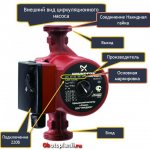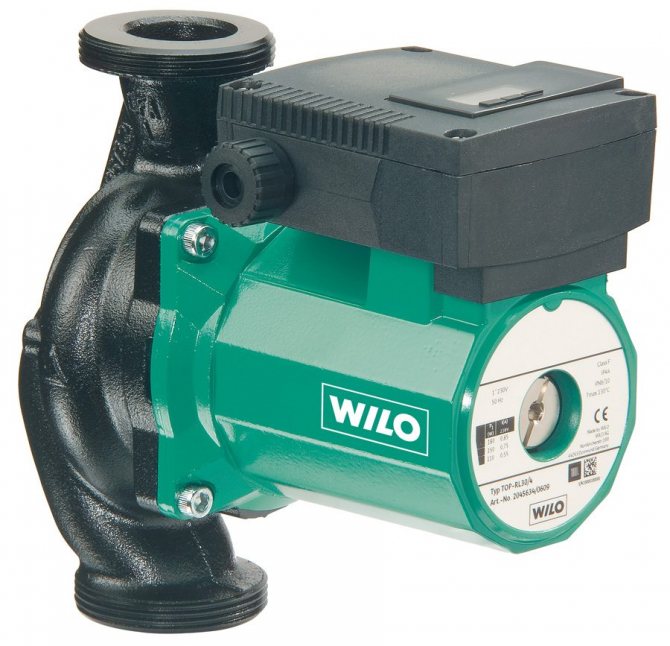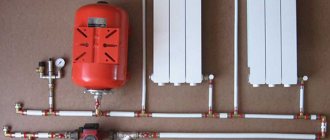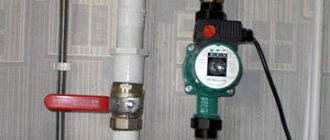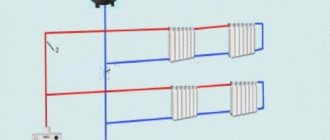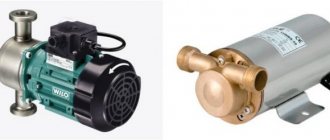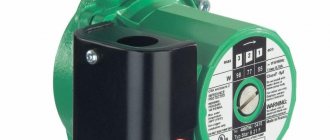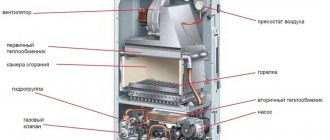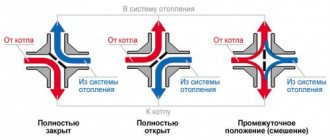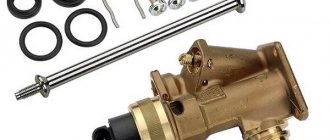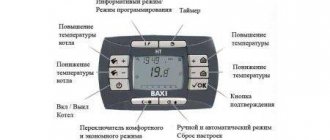Two main characteristics of a circulation pump
With a long list of heat pump specifications, there are two main ones. These are the diameter of the connection pipes and the power of the "accelerator". These two numbers are considered defining and are indicated in the name.
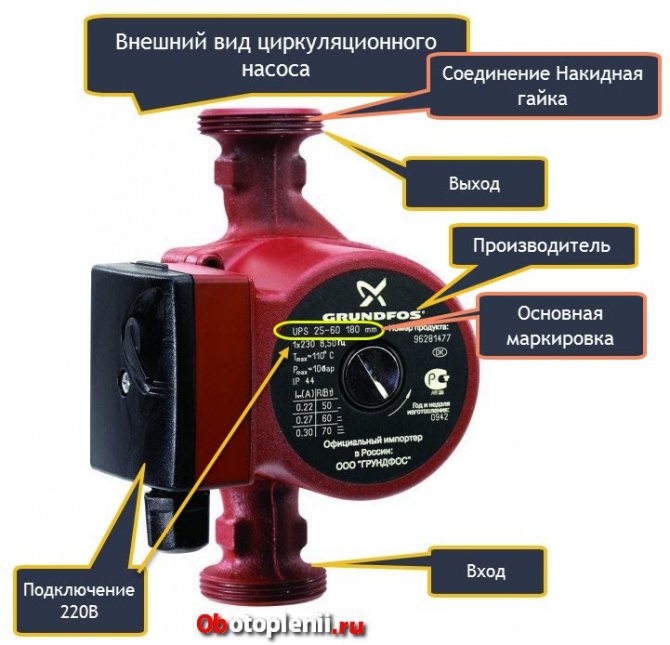
Connection pipe diameter
The most important parameter for installing a pump, especially with an already installed heating system. This is a numerical value indicated in millimeters and showing the diameter of the heating pipes that can be connected to the inlet / outlet pipes.
Please note that for connection on the nozzles of the body, taps with threaded threads are made.
Power
Power in heating systems is the ability to raise water to a certain height or pump head.
In the labeling of Grundfos pumps, the power is indicated in meters multiplied by 10 or atmospheres multiplied by 100. That is, Grundfos with the ability to raise water by 5 meters (head of 5 meters) will receive the number 50 or 0.5 atm in the labeling. (atmospheres).
Example: Circulation pump Wilo Star 30/2, means that the diameter of the connection pipes is 30 mm, the head is 2 meters.
In the Wilo marking, the power is indicated, simply in meters.
Example: Grundfos UPS 25 40 (130 mm) means that the diameter of the connection pipes is 25 mm (1/2 inch), the head is 4 meters. 130 is the installation length of the installation.
Where to put
It is recommended to install a circulation pump after the boiler, before the first branch, but on the supply or return pipeline - it doesn't matter. Modern units are made of materials that can tolerate temperatures up to 100-115 ° C. There are few heating systems that work with a hotter coolant, therefore considerations of a more "comfortable" temperature are untenable, but if you feel calmer, put it in the return line.
Can be installed in the return or direct pipe after / before the boiler before the first branch
There is no difference in hydraulics - the boiler, and the rest of the system, it does not matter at all whether there is a pump in the supply or return line. What matters is the correct installation, in terms of strapping, and the correct orientation of the rotor in space
Nothing else matters
There is one important point at the installation site. If the heating system has two separate branches - on the right and left wings of the house or on the first and second floors - it makes sense to put a separate unit on each, and not one common one - directly after the boiler. Moreover, the same rule remains on these branches: immediately after the boiler, before the first branch in this heating circuit. This will make it possible to set the required thermal regime in each part of the house independently of the other, as well as to save on heating in two-story houses. How? Due to the fact that the second floor is usually much warmer than the first, and much less heat is required there. In the presence of two pumps in the branch that goes up, the speed of movement of the coolant is set much less, and this allows you to burn less fuel, and without compromising the comfort of living.
There are two types of heating systems - forced and natural circulation. Systems with forced circulation cannot work without a pump, with natural circulation they work, but in this mode they have a lower heat transfer. Nevertheless, less heat is still much better than its complete absence, because in areas where electricity is often cut off, the system is designed as a hydraulic system (with natural circulation), and then a pump is cut into it. This gives high efficiency and reliability of heating.It is clear that the installation of a circulation pump in these systems is different.
All heating systems with underfloor heating are compulsory - without a pump, the coolant will not pass through such large circuits
Forced circulation
Since the forced circulation heating system is inoperative without a pump, it is installed directly in the break in the supply or return pipe (of your choice).
Most problems with the circulation pump arise due to the presence of mechanical impurities in the coolant (sand, other abrasive particles). They are able to jam the impeller and stop the motor. Therefore, a strainer-sump must be installed in front of the unit.
Installation of a circulation pump in a forced circulation system
It is also desirable to install ball valves on both sides. They will make it possible to replace or repair the device without draining the coolant from the system. Turn off the taps, remove the unit. Only that part of the water that was directly in this piece of the system is drained.
Natural circulation
The piping of the circulation pump in gravity systems has one significant difference - a bypass is required. This is a jumper that makes the system operational when the pump is not running. One ball shut-off valve is placed on the bypass, which is closed, all the time while the pumping is running. In this mode, the system works as a forced one.
Installation diagram of a circulation pump in a system with natural circulation
When electricity is lost or the unit fails, the crane on the lintel is opened, the crane leading to the pump is shut off, the system works like a gravity system.
Installation features
There is one important point without which the installation of a circulation pump will require alteration: it is required to turn the rotor so that it is directed horizontally. The second point is the direction of the flow. There is an arrow on the body indicating which direction the coolant should flow. This is how you turn the unit so that the direction of movement of the coolant is “in the direction of the arrow”.
The pump itself can be installed both horizontally and vertically, only when choosing a model, see that it can work in both positions. And one more thing: with a vertical arrangement, the power (created pressure) drops by about 30%. This must be taken into account when choosing a model.
What is BP / BP connection
The BP / BP detachable connection of the heating system is a set of adapters that allows you to connect the pipe to the pump casing.
- BP / BP stands for nut / nut;
- BP / HP stands for nut / thread.
BP / BP adapters are used to connect circulation pumps. Here is an example: Photo of an adapter for connecting a BP / BP pump (1 1/2 ″ - 1 ″). This means that the nut for the pump has a diameter of one and a half inches (32 mm), and the nut for connecting the pipe is an inch (25 mm).
On the pump nameplate and in its description, the diameter G is often indicated, this is the diameter of the union nut for the pump. Pumps are sold, which include connection adapters.
Note: Threaded connection of circulation pumps is typical for low-power domestic pumps. More powerful pumps are connected via flange connections.
Connection methods
Electrical connection with plug and socket. This method involves installing an electrical outlet in close proximity to the place where the circulation pump is installed. Sometimes they can come with a connected cable and plug included, as in the photo:
In this case, you can simply plug the device into the mains using an outlet located within the reach of the cable. You just need to make sure that there is a third, grounding contact in the outlet.
In the absence of a cord with a plug, they must be purchased in addition, or removed from an unused electrical appliance
Pay attention to the cross-section of the conductors of the cord.It should be between 1.5 mm2 and 2.5 mm2
The wires should be copper stranded to resist multiple bends. A cord with a plug for connecting electrical appliances to the network is shown in the photo below:
Before connecting the circulation pump, you need to find out which of the three wires of the cord is connected to the grounding pin of the plug. This can be done with an ohmmeter, while checking the integrity of the remaining wires.
Open the terminal box cover. There are three terminals inside the box, designed to connect the device to the network, with the designation as in the picture:
We unscrew the clamp of the cable box (in the first photo it is a plastic nut into which the cable is inserted), put it on our cord, put the cord into the box. If there is a cable clamp inside the box, thread the cord through it. We connect the ends of the wires of the cord pre-stripped from insulation with the terminals.
You need to connect the wires connected to the plugs to the L and N terminals (do not be afraid to mix them up, this is not critical), to the PE terminal you should connect the wire of the grounding contact of the plug (but you cannot be mistaken here). The instructions supplied with the product prohibit using it without protective grounding. Next, tighten the clamp (if available), tighten the cable gland clamp tightly, and close the terminal box cover. The pump is ready to be connected to the mains.
Fixed connection. The diagram for connecting the circulation pump to the mains with grounding is provided below:
The requirements for the cross-section of the wires are the same as in the previous version. With this installation, the cable can be used both flexible and inflexible, copper, VVG brand, or aluminum, AVVG. If the cable is not flexible, the installation must ensure its stability. For this, the cable is secured with clamps along the entire route.
In this version, a residual current device (differential circuit breaker) is used. Instead, you can use a conventional single-pole circuit breaker, passing only the phase wire through it. If the machine is installed in a panel where there is a PE bus, then the cable from the pump to the machine must be three-core. In the absence of such a bus, the PE terminal should be connected to the grounding device. This connection can be made with a separate wire.
Separately, I would like to consider such an installation option as connecting a pump to a UPS. It is the most preferred and ensures the independence of the heating system from power outages. The connection diagram of the circulation pump to the uninterruptible power supply is provided below:
The power rating of the UPS should be selected based on the power of the pump motor. The capacity of the storage battery is determined by the estimated autonomous power supply time of the circulation pump, that is, the time when the power grid is disconnected. We talked about how to choose a UPS for a boiler in a separate article. Requirements for cable cross-section, as well as for the presence of protective earth, apply to all connection options.
Finally, we recommend watching the video instructions for connecting various pump models to the electrical network:
Grundfos
Wilo Stratos-PICO
Connection diagram of the circulation pump to the thermostat
So we examined how the circulation pump is connected to the mains correctly. The diagram and video examples helped to consolidate the material and clearly see the nuances of the installation!
Grundfos circulating pumps markings
Explanation of the brand (Type) of the grundfos pump:
- UP - circulating;
- S - there is switching of power (speed);
- D - paired;
- 30 - diameter (mm dn) of the suction branch pipe and the pressure branch pipe;
- 60 - max. head (meters × 10);
- F - connection of pipes through a flange (the letter is absent for a thread);
- N - body material (cast iron body - no letters, letter N - stainless steel body);
- B - bronze body;
- A - housing has an air outlet;
- K - case for work with antifreeze (special version).
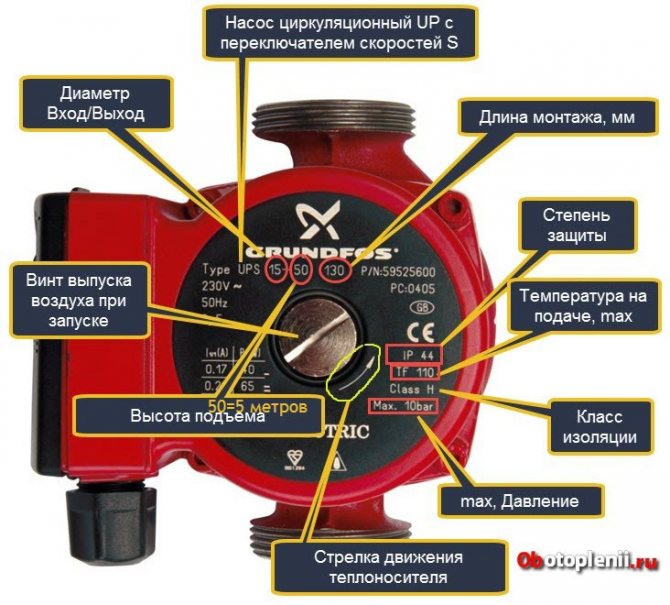

What is important to know?


The wiring diagram and methods of connecting a device such as a circulation pump to electricity can be of various designs. The choice of a specific option is determined by the characteristics of the heated object, as well as by the place where the device is located. There are two ways to connect it:
- direct connection to the 220 V power grid;
- connection to an uninterruptible power supply, which in turn is connected to a 220 V or 220/380 V network (in the case of a three-phase UPS).
Choosing the first method, the consumer runs the risk of being left without heating in the event of a prolonged power outage. This option can be considered justified only with a high degree of power supply reliability, which reduces the likelihood of a long power interruption to a minimum, as well as, if there is a backup source of electrical energy at the facility. The second method is preferable, although it requires additional costs.
Features of the
Not all manufacturers can offer a good high performance liquid transfer station. As a rare exception, the German concern Wilo can be called, the pumps of which can be presented in various variations. All offered models are distinguished by high-quality ergonomics and modern controls.
Wilo pumps can be used to provide hot water supply to any heating systems and various air conditioning systems, they are considered the most versatile type of equipment that is intended for small areas of the residential sector, multi-storey buildings and industrial applications.
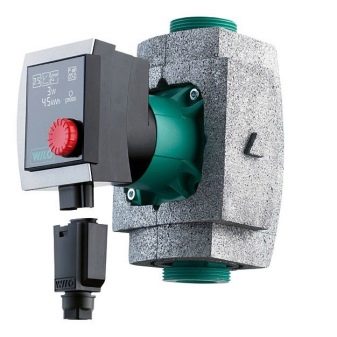

The advantages of pumps from Wilo:
- versatility and wide scope;
- significant savings;
- compact dimensions of components;
- corrosion protection;
- reliability and durability of the device;
- overheat protection;
- reliable cleaning system;
- acceptable prices.
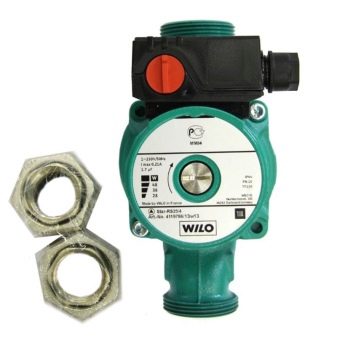

The technical characteristics of circulation devices for heating Wilo can be called several parameters.
- Convenient control as a mechanical or electronic switch. You can adjust the power and speed of movement of the coolant.
- Electronic control models have a built-in thermostat.
- The electric motor and rotor will be protected from power surges.
- Operating characteristics of the device: water column head from 1 to 7.5 m, heated area - from 100 to 2200 m2, throughput capacity - from 1 to 12 m3 per hour. Operating temperature parameters from -10C to + 110C.
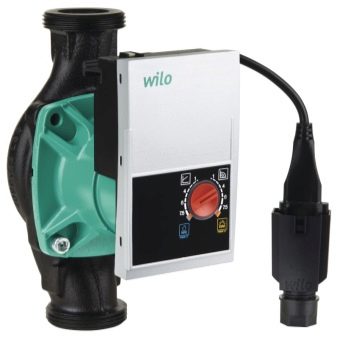

The manufacturer offers the consumer an assortment, the technical characteristics of which are almost the same, the main difference is only in the parameters of the flange.
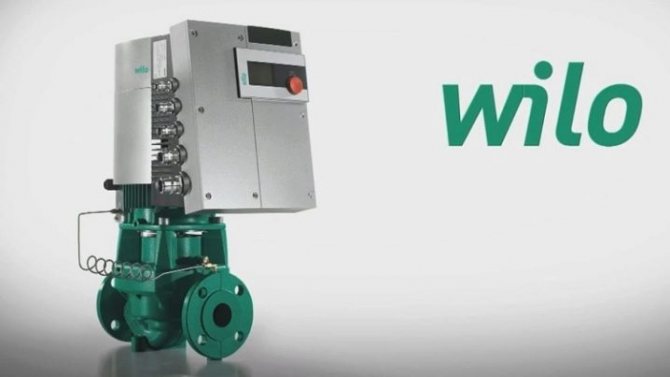

Wilo Star Series
The Star-RS unit is a low power unit that is perfect for home use. The body is made of high quality cast iron, the impeller is made of plastic, and the shaft is made of stainless steel. It is used for pumping clean water in which there are no abrasive substances and various impurities.
The RS series includes 12 samples, which are named from 15-4 to 30-8. These circulation products for heating have a capacity of 6,000 liters per hour at a normal pressure of 10 atmospheres.
- Star-RS 25/4 - this is a surface type pump for clean water, throughput - 3 m3 per hour, water pressure - 4 m, power 68 W.
- Wilo pump 25/6 purchased for water supply in small heating systems and closed systems.
They can be chosen for apartment buildings and private houses.
- Circulating device Wilo Star-RS 25/7 for heating systems - three-speed equipment with a threaded connection.
- Product Wilo Star RS 25/2 with thread connection and wet rotor.Designed for installation in air conditioning, heating and cold water supply systems, as well as in industrial systems.
- Wilo Star Z Series Nova Is a device with a wet rotor and a synchronous electric motor, resistant to blocking currents, used in industry for equipment of various types of structures.
- Aggregates Wilo-Star-RS 30/8 are used to work in different temperature parameters: with ventilation units, with various radiators, underfloor heating systems. And they are also used in room air conditioning systems.
- Star-RSD - this is a double mechanism, which allows to increase reliability in operation: when the first mechanism breaks down, the second one starts working automatically. Otherwise, the devices work simultaneously, but water will be supplied through different lines: separately for heating and hot water supply.
There are two models to choose from: 30-4 and 30-6.
Wilo Stratos-Eco
This is the most advanced electronic version, which was released for the operation of boiler rooms with low power. The regulator of the device will control the operation of any heating system, which guarantees savings in the use of the resource and its operation at the lowest temperatures. The Wilo product is represented by seven markings: from 25 / 1-8 to 65 / 1-2, which are equipped with a wet rotor and are suitable for DHW with a large volume of oxygen.
The Wilo Stratos-Zd has a pre-set speed for continuous automatic day-night operation. Available in 2 types: 32 / 1-12 and 40 / 1-8.
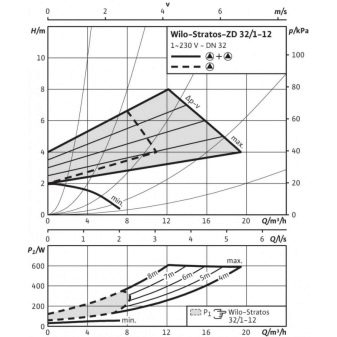

Wilo Top and DHW
This series is used for space heating systems that have an area of more than 1,500 m2. Circulating devices of the Wilo Top brand have a water pressure of up to 10 m of water column with a working pressure of 10 bar. Flanged pumps can be found among Wilo Top.
- Top-Rl and Top-S - equipment of a two-phase type, carrying out high-quality work in a continuous mode. The pumps operate at temperatures from -20 to +130 C, can be used for a separate circuit in closed-loop water supply and hot water supply systems.
- Top-S 40/10 - does not require maintenance, has a threaded or flange connection; if desired, you can select the speed steps for precise power control.
- Pump Top-S 50/15 can be used for various water heating systems, air conditioning, refrigeration and industrial systems with circulation.
- Top-Z series unit needed for pumping drinking water. Quiet operation is ensured by the wet rotor design. Full protection of such a motor is guaranteed by an electronic shutdown system.
Pumping equipment is placed even in the most unsuitable places.
Heating equipment Wilo
These devices, which also work for hot water supply, were released by the company not so long ago. This equipment is adapted to water with a relative degree of hardness with a low content of magnesium and calcium. In the models of this series, the impeller is made of stainless steel.
The modification was specially developed for large heating systems. Such equipment can be connected to boilers with a capacity of 25 kW or more.
The characteristic features of the Wilo Stratos device with an electronic control unit can be considered:
- power of the Wilo 2 product - 48 W;
- there is a night mode when the use of electricity decreases;
- automatic adjustment of operating parameters - the controller is connected to a thermostat, which will allow you to select the optimal speed and performance depending on your needs.
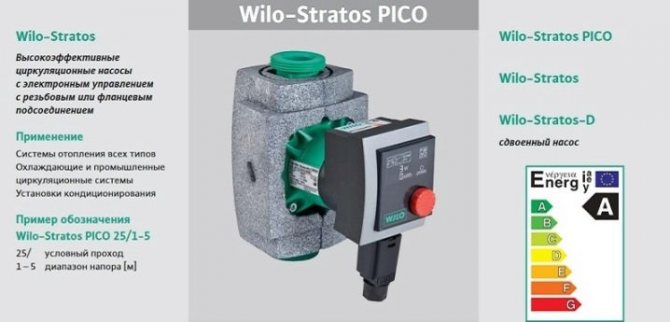

Wilo yonos
It has an electronic control unit, protection against airing of the system and the function of removing solid particles from the environment of a specific coolant.
Advantages and disadvantages of Grundfos well pumps
The products of this brand are distinguished by a lot of advantages that are inherent only in it:
- Well pumps have a high efficiency rate with minimal energy consumption, and are connected to a household electrical network.
- There is protection against faults. Reliability is provided by a system that will automatically turn off the device if water leaves the well.
- Autonomy is an indicator of comfort. The submersible pump is turned on only when necessary when the tap is open or another consumer is started.
- Overheating is excluded. The device is designed in such a way that hot air is removed from the working parts, which allows the temperature to be kept within the normal range.
- The robust, robust housing is made of stainless steel that does not corrode and withstands the pressure exerted on it during operation.
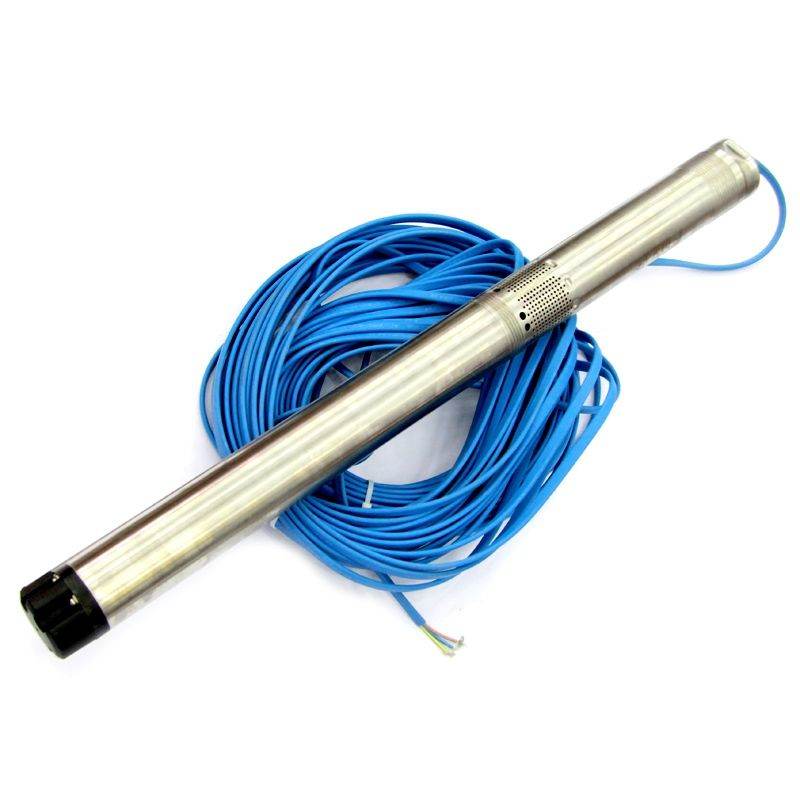

All mechanical components are made of durable metals and alloys. Bearings, for example, are made of cermet with tungsten.
The only drawback can be considered the sensitivity to voltage drops, but this is more likely a lack of an electrical network than a device. By equipping the electrical circuit with a stabilizer, the user will permanently solve this problem, and the Grundfos borehole pump will work for many years.
Types of pumps for circulation
These devices installed in the heating circuit can have a different design, which affects their operation. There are Grundfos pumps with wet and dry rotor. Each species has its own characteristics, strengths and weaknesses.
Wet rotor
Such devices are best suited for heating country houses and are installed in small boiler rooms. Thanks to their optimum design, they are compact and quiet in operation.
They are called "wet" due to the fact that they use a water-cooled electric motor. The coolant pumped by the pump additionally lubricates the equipment parts.
Such devices do not require additional maintenance, and their efficiency is 50%. They are capable of effectively performing their task for 8-10 years. A "wet" pump is quite sensitive to the quality of the coolant. For this reason, it is not recommended to install it if there are foreign inclusions in the water. Also, the device is not suitable for circulating cold liquid.
The regulation of such pumps can be manual or automatic. The second option is considered more economical, since the unit independently adjusts to the characteristics of the heating network. Products with automatic adjustment are also distinguished by their quiet operation. The air is also removed by itself, without the intervention of the owner.
If we compare the appearance of pumps with a wet and dry rotor, then the fins are not provided on the casing and impeller of the former.
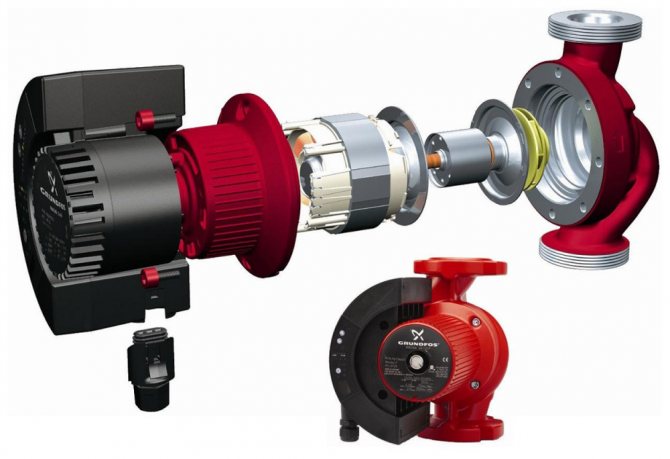

Dry rotor
This type of equipment appeared somewhat later than units with a wet rotor. The key difference is that the pump motor does not come into contact with the liquid during operation.
The efficiency indicator reaches 70%. As a rule, such equipment is in demand when pumping significant volumes of coolant. Therefore, it is most often installed in large rooms for domestic and industrial purposes. Special seals are provided between the rotor and the fluid in the system.
The disadvantage of dry rotor devices is that they are quite noisy, so they should be installed in a special room or installed with special insulation. To prevent the equipment from overcooling during operation, a fan is provided in the design. Devices of this type serve for about 6 years.
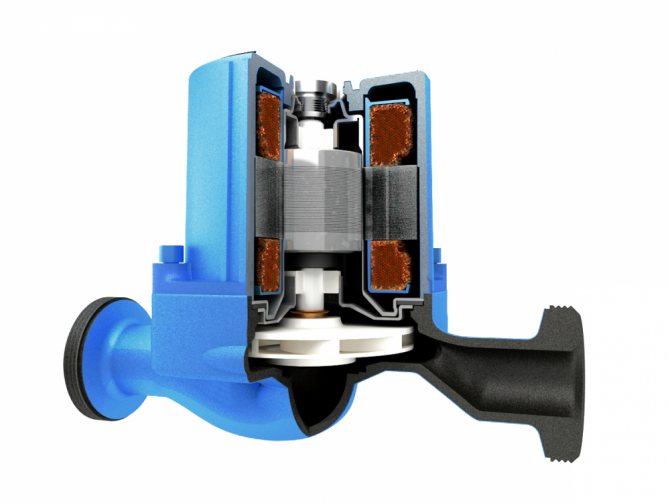

Prices for a range of Grundfos circulation pumps
Grundfos circulating pumps
Top SQ model for wells
Assessing the technical characteristics of Grundfos pumps and the demand for them, it is safe to say that the SQ series is universal.
This equipment was created so that homeowners could establish water supply to their homes, summer cottages, cottages, as well as organize watering of their personal plot. It is impossible to say that there is a specific model recognized as the best in the line.
All of them are reliable, suitable for pumping water from wells to sand, Abyssinian and artesian basins. And all thanks to the fact that the latest technologies and modern materials are used in the manufacture. But the SQe series is specially designed for deep water artesian wells with clean drinking water. All modifications are equally reliable and differ in characteristics.
Electrical connection
Circulation pumps are operating from a 220 V network. Connection - standard, a separate power line with a circuit breaker is desirable. For connection, three wires are required - phase, zero and ground.
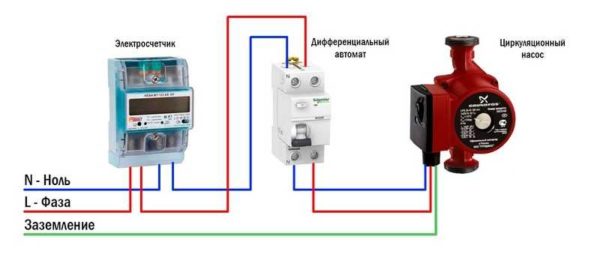

Circulation pump electrical connection diagram
The very connection to the network can be organized using a three-pin socket and plug. This method of connection is used if the pump is supplied with a connected power cable. It can also be connected via a terminal block or directly with a cable to the terminals.
The terminals are located under the plastic cover. We remove it by unscrewing a few bolts, we find three connectors. They are usually signed (there are pictograms N - neutral wire, L - phase, and "earth" has an international designation), it is difficult to make a mistake.
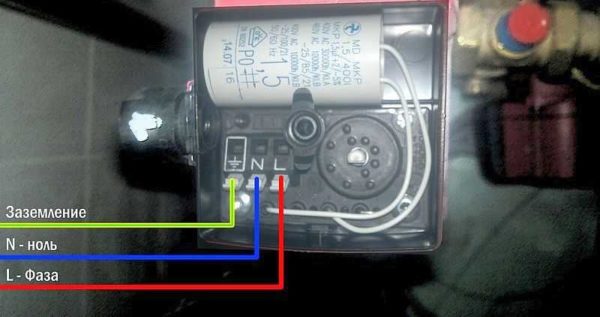

Where to connect the power cable
Since the entire system depends on the performance of the circulation pump, it makes sense to make a redundant power supply - to put a stabilizer with connected batteries. With such a power supply system, everything will work for several days, since the pump itself and the boiler automation "pull" electricity to a maximum of 250-300 watts. But when organizing everything, you need to calculate everything and select the capacity of the batteries. The disadvantage of such a system is the need to ensure that the batteries are not discharged.


How to connect a circulator to electricity through a stabilizer
The performance of the heating system in many multi-storey buildings is not satisfactory. This is due to the small diameter of the pipes used, through which water flows, and too low pressure. If the second problem is solved, then it will be possible not to think especially about problem number one, since with the help of a good circulation pump it will be possible to ensure the normal movement of the carrier along the wiring, thus increasing the efficiency of the entire system.
Operating tips
Several key recommendations can be offered, which will ensure long-term operation of this type of equipment.
- You can leave the device in continuous operation without fear.
- Experts advise sometimes to turn on the equipment for 10-20 minutes after the heating season is over.
- It is possible to turn on the equipment only if the heating system is filled with a carrier.
- Models that have a wet rotor in their structure use a coolant for lubrication. When switched on, if there is no lubricant, the bearings can burn out very quickly.


You can learn how to connect a circulation pump to a heating system from the following video.
Installation
The installation of the Wilo unit in the heating system must be carried out in full compliance with the existing operating instructions provided by the manufacturer. There are several important rules to follow during installation.
- Only vertical installation of units of this company is allowed. Horizontal placement of Wilo pumps in the system is strictly prohibited. The only exception will be those models that are specifically designed for horizontal connection. The installation position of a particular pump can be found in the detailed instructions.
- Connecting the underfloor heating system - the device is installed in a special unit.The correct placement of the Wilo heating product will be indicated by arrows, which are located on the body of the unit itself and on the hydraulic wiring.
- Connection to a radiator-type heating system - installation is carried out in the heating return line, right in front of the boiler. In order to prevent a complete stop of the circulation of the coolant, a bypass is also installed here.
The installation rules for Wilo devices allow you to choose equipment for heating systems with both natural circulation and forced circulation.
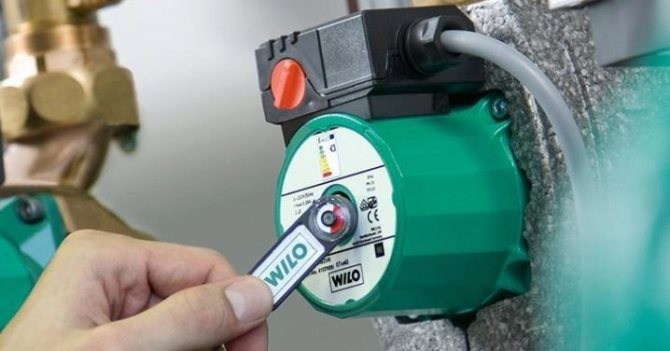

- Installation and maintenance - the pump is mounted vertically, observing the direction of the coolant, which will be indicated by arrows on the body and assembly. Installation should only be performed by qualified technicians.
- Device mounting methods will depend on the model chosen, as a rule, they are described in some detail in the instructions. Provided that the connection is correct, the Wilo pump does not require any special maintenance.
- On the bypass frame, a coarse filter must be installed immediately in front of the pump. Take into account all the specifics of the installation of the Wilo heating pump, disassemble and assemble it back, only an experienced specialist can carry out repairs. Installation of the device takes just 2-3 hours
If you also install a bypass, it will take 4-6 hours.
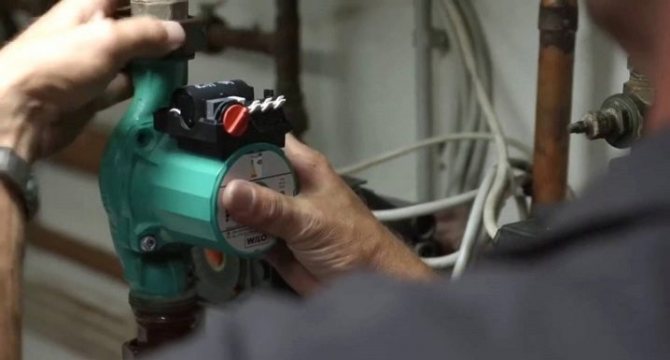

Connection stages:
- the pump is assembled, the connection point on the circuit is selected;
- the water is turned off, there is a tie-in into the heating system;
- the device is being mounted, the main thing is to install it in the correct position;
- connections are tightened and sealed;
- the product is connected to electricity;
- fluid is supplied to the circuit and the device starts up;
- tested in working mode.
Extraneous hum during device operation will indicate a number of possible malfunctions. The air vent may become clogged and prevent air from the system. Another common malfunction will be an incorrectly selected mode of operation.
Reducing the speed of the device with your own hands usually leads to the disappearance of the hum. If this does not happen, the pump needs to be serviced.
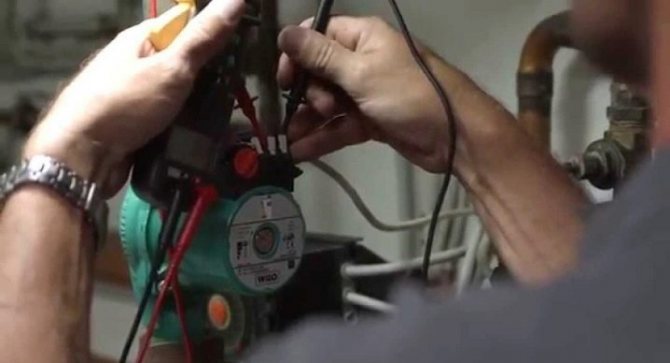

Device
The company manufactures pumps of two subspecies:
- with dry rotor;
- with a wet rotor.


Dry rotor pumps
This type of pump indicates that the rotor of the electric motor does not have contact with water. The connection of the engine itself with the working part is made with the help of special O-rings, which will not allow the used fluid to find itself in the electric drive.
This unit consists of two parts: the 1st part is the electric motor itself, the 2nd part is a body with two nozzles - one discharge type nozzle, the other suction type. In addition, it has an impeller for pumping.
Pumps of this type are used in systems with a fairly long pipeline length and large diameter. Most often they can be found in industrial and heating boiler houses.
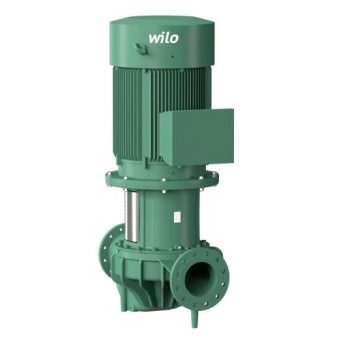

The main indicators of the device:
- high level of efficiency - more than 80%;
- it is necessary to install filters to prevent foreign objects and particles from entering the product.
The room where this equipment will be installed must be free of dust, otherwise the O-rings will quickly become unusable. Replacing the rings will be quite difficult, only a specialist can do this. The connection type is usually flanged.
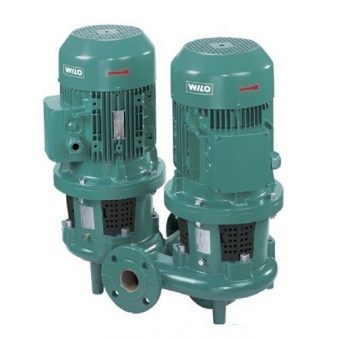

Wet rotor units
This product is often used for domestic needs. The design of such pumps will differ significantly from other models. The electric motor and impeller are located in the housing itself, which has both an inlet and an outlet. The transfer of the coolant is carried out, as it were, by the rotor itself, which is equipped with an impeller.
The bearings are cooled and lubricated by the pumped liquid itself.This product is used in heating systems with a short length and small diameters of pipelines. They are connected by a threaded connection.
The main indicators of the equipment:
- almost silent operation;
- has the most compact design;
- if necessary, you can change the operating parameters, which will help to seriously save on electricity consumption;
- long term of work;
- requires almost no constant maintenance.


Models of units with a wet rotor for various heating systems are equipped with three-mode blocks for adjusting the impeller speed. These blocks are controlled manually. The temperature parameters in which such units can operate are from - 20 to +130 degrees.
To correctly connect the selected pump, be sure to familiarize yourself with the electrical connection diagram, and best of all, contact an experienced specialist.
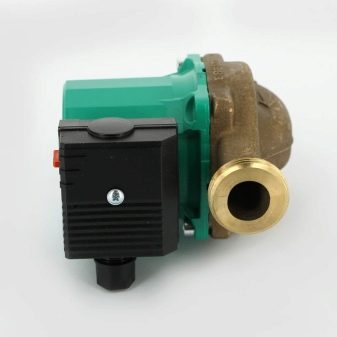

Popular models and features of Grundfos pumps
There are over 30 Grundfos well models. They are protected against voltage surges, dry running, equipped with a soft starter and pressure sensors. The mechanisms automatically adjust the shaft speed and respond in time to engine overheating. It is not difficult to choose the right pump brand. You just need to know the depth of the well and the required volume of water consumption at home.
The most common units are the SQ, CR, SPO series, as well as the new line of submersible Sba and Sb submersible mechanisms. Basic SB models are affordable household well installations. The SBA differs in that this equipment is equipped with an additional control unit.
SQ Series Well Pump
The SQ single speed pump is well suited for wells with automatic controls. The range of 3-inch wells has a wide range of positive characteristics. All devices are made of high-tech stainless steel and composite materials.
AC power from the public grid is used to drive the pump. The mechanism is equipped with a built-in frequency converter, which allows maintaining a constant pressure in the system.
Technical features:
- power 1.15 kW;
- productivity 3 m³ / h;
- immersion depth 30 m;
- head force 89 m;
- dry running protection;
- high efficiency of the electric motor;
- wear resistance;
- "soft start" system;
- increased body tightness;
- protection against power surges.
Features of the KR series


Well pump Grundfos CR.
The CR pump is a multistage vertical unit with normal suction. The unit body is made of cast iron, titanium or stainless steel. The devices are equipped with electric motors with an adjustable rotation frequency with a power of 0.25-3.0 kW (220 V).
The cylindrical casing and intermediate chambers are connected to the base with long tie bolts (in-line).
This design of the equipment allows its installation both on vertical and horizontal pipelines. Pumps of the KR series are designed for pumping and increasing the pressure of hot and cold liquids without fibrous and solid inclusions.
The generated head force is 270 m. Productivity is 180 m³ / h.
The principle of operation of CR pumps is based on increasing the pressure of the water moving from the inlet to the outlet. The working shaft of the unit is equipped with spiral-shaped metal blades. Liquid from the suction line enters the pump impeller and is thrown to the walls of the casing. After that, water under high pressure enters the pressure line.
All equipment in this model range is equipped with a mechanical shaft seal and does not require any maintenance.
Peculiarities of using Grundfos sro
The Grundfos SPO 5-inch submersible well pump is used for domestic water systems.It is used for pumping clean liquids from underground sources and storage tanks.
The pump body is made of corrosion-resistant materials. All samples are supplied with a single-phase electric motor. The drive is installed in the upper part of the unit. The pumped liquid flows between the housing of the device and the motor casing, providing efficient cooling of the installed equipment.
Specifications:
- productivity - 6.5 m³ / h;
- head force - 75 m;
- liquid temperature - up to 40 ° С;
- case diameter - 140 mm;
- weight - 15-20 kg;
- immersion depth - 20 m.
Grundfos pumps of this model can be produced in 2 versions: with a support-base and a filter grid.
SPO units are designed to lift only clean water. They are not suitable for pumping liquids with fibrous and abrasive solids. To protect the equipment from premature wear, strainers are installed on the suction pipes of the units. The grilles can be easily removed from the device body for maintenance and repair.
Base pumps are versatile devices. They can be installed on the bottom of the pool (under water) or placed next to the storage tank.

